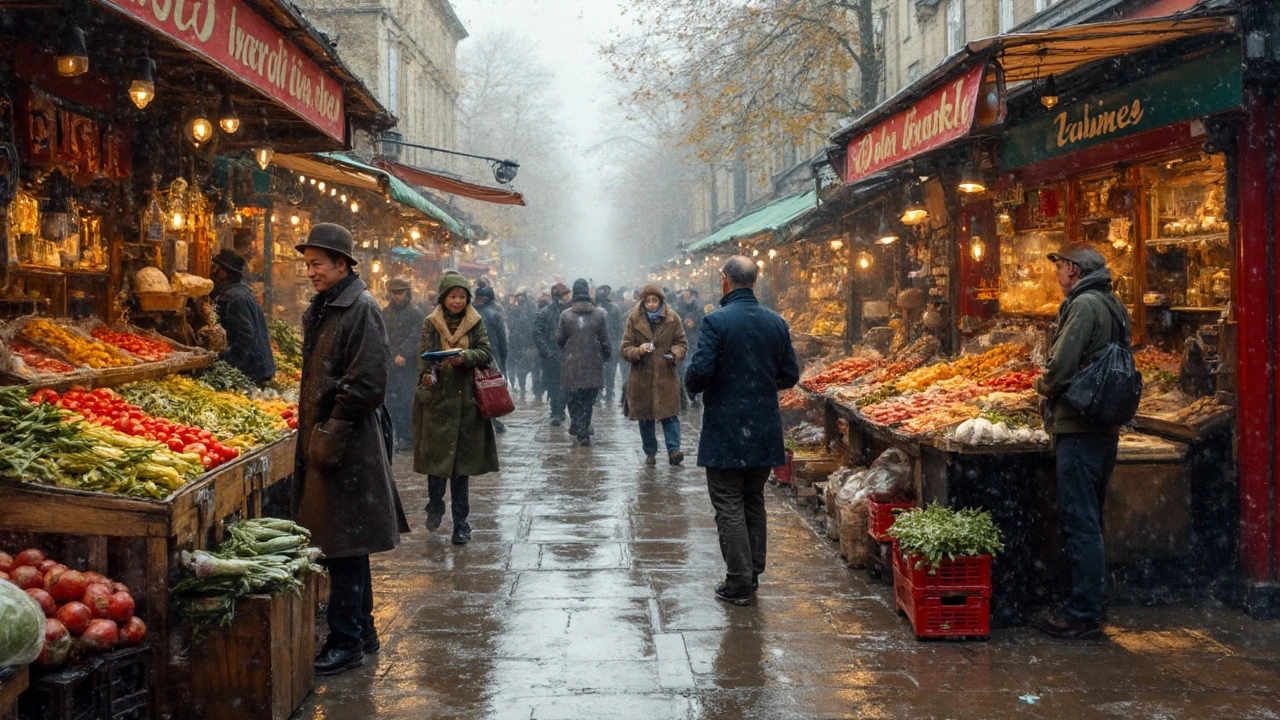
Checked your grocery bill and had to double-check the total? You’re not imagining things—food prices across the UK are definitely moving up, and it’s not just by a little bit. People in London especially have it tough since city living is already pricey. So, what’s really going on, and more importantly, what can you actually do about it?
It’s not just a headline, and it's not panic for nothing; the Office for National Statistics showed that food inflation still sits above 5% year-on-year, even if it’s slowed down compared to last year’s spikes. That means almost everything—from eggs to apples—costs more than it did even a few months ago. If your favourite brand of bread or milk jumped in price lately, you’re definitely not alone. Loads of people are feeling the same thing at the local Tesco, Aldi, or even the corner shop.
Don’t think you just have to take these prices on the chin. There’s more behind the jump than meets the eye, and there are smart ways to shop that can help you claw back some control over your budget. If you’re tired of watching your weekly food shop eat bigger chunks out of your pay, stick around for some practical, simple tips and straight talk on what’s driving these costs.
- What's really happening with food prices?
- Why is everything getting more expensive?
- Who gets hit hardest by price rises?
- How you can save on your weekly shop
- Are things going to get better soon?
What's really happening with food prices?
Let’s get straight to it: food prices in the UK shot up faster than paychecks for most of last year. The surge started in 2022 and didn’t really ease off through 2023. Even now, in 2025, prices at London supermarkets are still high compared to just a couple of years ago. And it’s not just posh stuff—staples like bread, milk, cheese, and meat have all seen steep jumps.
The Office for National Statistics says food and drink inflation peaked at nearly 20% last spring, which hasn’t happened in over 40 years. Since then, rates have slowed a bit, but the costs haven’t really dropped—they’ve just stopped rising quite so quickly. In other words, we’re all paying more, but at least the increases aren't as wild as before.
| Item | Average Price (2022) | Average Price (2025) |
|---|---|---|
| Milk (4 pints) | £1.15 | £1.55 |
| Loaf of bread | £1.10 | £1.49 |
| Cheddar cheese (200g) | £1.80 | £2.20 |
| Eggs (12) | £2.00 | £2.40 |
Everyone’s feeling it, but Londoners cough up a bit more thanks to higher rents, transport, and fewer cheap food options nearby. Plus, smaller local shops often charge more than the big chains. Some folks are switching brands, grabbing own-label products, or just buying less. You’ll see the difference most on things like fruit, veg, and imported goods—anything that relies on weather or world events for supply.
With UK food prices so unpredictable, it’s turning smart shopping from a hobby into a skill. The key takeaway: the rise might be slowing, but don’t bet on prices dropping back down anytime soon.
Why is everything getting more expensive?
The jump in food prices across the UK isn’t just about supermarkets looking to make bigger profits. A pile of different reasons have come together to push up the cost of just about everything you eat or drink. Most of these are things we don’t see when we're in the shop, but they hit our wallets all the same.
One major driver is the cost of energy. It takes a ton of energy to grow, pack, transport, and store food, especially frozen and chilled stuff. Since the start of 2022, energy bills for farms and factories have gone through the roof. When it costs more to keep the lights on and the machinery running, that extra spend gets baked into the price tag on the shelf.
Then there’s the price of fuel. Higher fuel costs mean delivery trucks, which move food from suppliers to supermarkets all over London, are more expensive to run. When petrol and diesel prices go up, your weekly shop almost always follows.
Brexit’s still having an impact, too. New import checks, rules, and the weaker pound have made it pricier and trickier to bring certain goods into the UK. Think about things like cheese, pasta sauce, or fresh salads from Europe—anything that’s imported might cost you noticeably more than before.
Let’s not forget climate problems. Floods and droughts across the world, from Spain’s salad farms to cocoa plantations in Ghana, have hit crop yields. Less supply means higher prices, and with staple foods like veggies, bread, and chocolate, you really do feel the difference when a harvest fails.
Here’s a quick look at what’s been changing the most in the last 12 months:
| Food Item | Average % Price Rise (2024) |
|---|---|
| Olive Oil | +30% |
| Sugar | +15% |
| Cheese | +10% |
| Pasta | +12% |
| Milk | +7% |
When you stack up higher energy costs, more expensive imports, supply problems, and even packaging costs, it’s no wonder your supermarket receipt looks different nowadays.

Who gets hit hardest by price rises?
If you’re wondering who feels the pain most when food prices climb in the UK, it’s not hard to spot. Households with lower incomes really struggle when the cost of basics like bread, pasta, and milk shoot up. They spend a bigger share of their money on food, so even a small hike at the shops hurts more than it does for wealthier folks. According to the Trussell Trust, food bank use in London shot up by over 30% from 2022 to 2024—a clear sign that some families just can’t stretch the budget any further.
Pensioners and single-parent families also take a heavy hit. A report by the Joseph Rowntree Foundation found that nearly one in five single parents in the UK cut back on meals or skipped them altogether in the last year due to rising food prices. It’s not just about choosing cheaper brands, either; many are forced to drop whole categories—like fresh fruit or meat—just to keep the fridge stocked.
People who rely on public benefits or have irregular work face an even tougher time. Disability campaigners flagged that costs for specialist foods and allergy-safe products jumped even more steeply—sometimes double the average inflation rate. For many, that means compromising health for affordability.
Take a look at this quick breakdown to see how different groups are impacted by the hike in UK food prices:
| Group | Percentage Spending on Food | Extra Strain from Price Hikes |
|---|---|---|
| Low-Income Households | 30% of income | Very High |
| Single-Parent Families | 25% of income | High |
| Pensioners (Living Alone) | 20% of income | High |
| Average Household | 14% of income | Moderate |
If you’re in one of these groups, it’s honestly tough. The key takeaway? Rising food prices in the UK are hardest to handle for the people who had the least wiggle room in the first place. If you know someone struggling, pointing them towards local food banks or community kitchen schemes can sometimes help soften the blow. Even simple things like meal sharing or bulk buying with neighbours are getting more common and make the price pinch a little easier to handle.
How you can save on your weekly shop
Now’s not the time to shop without a plan—food prices aren’t likely to fall anytime soon in the UK. So if you want to spend less in London, you’ve got to shop smart. Here’s what’s working for plenty of folks right now:
- Look out for supermarket loyalty schemes: Big names like Tesco and Sainsbury’s hook you up with clubcard or Nectar card prices, and it does add up. Some shoppers save between £3 and £7 per week just by swiping these cards at checkout.
- Go for store brands or own-label goods: A Which? survey last month found that switching to supermarket brands can shave up to 30% off your bill. Often, these items taste nearly the same as big brands—just less packaging and flashy ads.
- Check for yellow-sticker bargains: If you time your shop for evenings, most supermarkets reduce prices on fresh foods getting close to their sell-by dates. Bread, veggies, meat—you could easily fill part of your fridge with yellow-sticker deals.
- Use a meal plan and shopping list: Impulse buying wrecks budgets. Write your meals for the week on your phone or a sticky note and stick to it. Cutting back on last-minute treats can save an average London family over £20 a week, according to MoneySavingExpert.
- Shop around and compare prices online: Prices are all over the map between stores, especially on basics like milk and fruit. Online clued-up shoppers use apps like Trolley.co.uk to check who’s got the best deal before heading out.
If you want to see just how much a smart shop can save, check out this breakdown of what switching brands can do for some popular staples:
| Item | Brand | Store Brand | Avg. Saving per Week |
|---|---|---|---|
| Milk (4 pints) | £1.65 | £1.35 | £0.30 |
| Sliced Bread (800g) | £1.25 | £0.75 | £0.50 |
| Cheddar Cheese (400g) | £3.00 | £2.20 | £0.80 |
Little changes really stack up over a month or two. And if you’re really feeling the pinch, sticking to local markets for fruit and veg often beats supermarket prices, especially on weekends when stalls are clearing out stock. Save where you can, and there’s no shame in hunting out the bargains. Everyone’s doing it.

Are things going to get better soon?
Lots of people in London are asking if food prices are ever coming down or at least slowing their crazy rise. Here’s the deal: experts say the wild price jumps we saw during 2022 and 2023 have calmed down, but that doesn’t mean food is suddenly going back to what it cost before COVID hit. Prices are still edging up, just at a slower pace compared to last year.
The Bank of England reckons that UK inflation overall is dropping, which usually helps with costs at the supermarket. In March 2025, headline inflation sat at around 3.2%, according to the ONS. Food inflation was higher—about 5.3% year-on-year. This isn’t great, but it’s better than last year when food inflation went into double digits.
| Month | Headline Inflation | Food Inflation |
|---|---|---|
| March 2024 | 3.4% | 7.0% |
| March 2025 | 3.2% | 5.3% |
But will you notice it in your wallet? Maybe, but don’t expect some miracle drop overnight. Supermarkets like Tesco and Sainsbury’s have already started cutting prices on things like pasta, bread, and milk. Still, supply chain hiccups and higher wages for food workers keep some prices higher than we’d like. Add in unpredictable stuff like bad weather or global conflicts, and it’s clear no one can promise steady savings just yet.
The good news: many banks and experts think most of the crisis is behind us. If you’re clever with deals and switch to own brands, you can stretch your money further. Keep an eye out for price drops and avoid panic-buying when you see some headlines—sometimes the media makes it sound scarier than it is.
- Look for supermarket loyalty card deals and digital coupons
- Shop late in the day for yellow sticker discounts
- Switch to supermarket own brands—they’re usually much cheaper
No magic fix just yet, but the worst of the food prices chaos should be easing up. Watch for small, slow savings in your weekly shop and keep hustling for bargains.